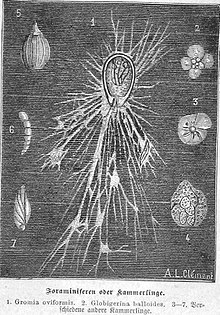| Gromia | |
|---|---|

| |
| Gromia (1) and some foraminiferans (2–7) | |
| Scientific classification | |
| Domain: | Eukaryota |
| Clade: | Diaphoretickes |
| Clade: | SAR |
| Phylum: | Endomyxa |
| Class: | Gromiidea |
| Order: | Gromiida |
| Family: | Gromiidae Reuss, 1862 |
| Genus: | Gromia Dujardin, 1835 |
Gromia is a genus of protists, closely related to foraminifera, which inhabit marine and freshwater environments. It is the only genus of the family Gromiidae. Gromia are ameboid, producing filose pseudopodia that extend out from the cell's proteinaceous test through a gap enclosed by the cell's oral capsule. The test, a shell made up of protein that encloses the cytoplasm, is made up of several layers of membrane, which resemble honeycombs in shape – a defining character of this genus.
Gromia were first discovered in shallow waters, with members of the best-characterized species Gromia oviformus often found inhabiting rock surfaces, sediments, or seaweed holdfasts. However, research from the 1990s and early 2000s identified gromiids inhabiting depths up to 4,392 m, leading to several new deep-sea Gromia species being described and recognized.[1]
A recent study of the deep-sea species Gromia sphaerica revealed that it produces traces on the seafloor which resemble fossil traces formerly attributed to early Bilateria (animals with bilateral symmetry); this now calls into question whether such fossil traces are reliable as documentation of early multicellular animal diversification in the Precambrian era.[2]
Deep-sea gromiids have also been shown to be important for carbon cycling[1] and denitrification.[3]
- ^ a b Rothe, N.; Gooday, A.J.; Cedhagen, T.; Hughes, J. Alan (2011). "Biodiversity and distribution of the genus Gromia (Protista, Rhizaria) in the deep Weddell Sea (Southern Ocean)" (PDF). Polar Biology. 34 (1): 69–81. doi:10.1007/s00300-010-0859-z. S2CID 22228614.
- ^ Matz, M.V.; Frank, T.M.; Marshall, N.J.; Widder, E.A.; Johnsen, S. (2008). "Giant deep-sea protist produces bilaterian-like traces". Current Biology. 18 (23): 1849–1854. doi:10.1016/j.cub.2008.10.028. PMID 19026540. S2CID 8819675.
- ^ Høgslund, S.; Cedhagen, T.; Bowser, S.S.; Risgaard-Petersen, N. (April 2017). "Sinks and sources of intracellular nitrate in Gromiids". Frontiers in Microbiology. 8 (April): 617. doi:10.3389/fmicb.2017.00617. PMC 5397464. PMID 28473806.